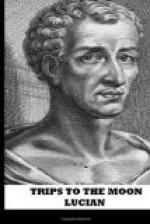The best translation of the works of Lucian into English was that by Dr. Thomas Francklin, sometime Greek Professor in the University of Cambridge, which was published in two large quarto volumes in the year 1780, and reprinted in four volumes in 1781. Lucian had been translated before in successive volumes by Ferrand Spence and others, an edition, completed in 1711, for which Dryden had written the author’s Life. Dr. Francklin, who produced also the best eighteenth century translation of Sophocles, joined to his translation of Lucian a little apparatus of introductions and notes by which the English reader is often assisted, and he has skilfully avoided the translation of indecencies which never were of any use, and being no longer sources of enjoyment, serve only to exclude good wit, with which, under different conditions of life, they were associated, from the welcome due to it in all our homes. There is a just and scholarly, as well as a meddlesome and feeble way of clearing an old writer from uncleannesses that cause him now to be a name only where he should be a power. Dr. Francklin has understood his work in that way better than Dr. Bowdler did. He does not Bowdlerise who uses pumice to a blot, but he who rubs the copy into holes wherever he can find an honest letter with a downstroke thicker than becomes a fine-nibbed pen. A trivial play of fancy in one of the pieces in this volume, easily removed, would have been as a dead fly in the pot of ointment, and would have deprived one of Lucian’s best works of the currency to which it is entitled.
Lucian’s works are numerous, and they have been translated into nearly all the languages of Europe.
The “Instructions for Writing History” was probably one of the earliest pieces written by him after Lucian had settled down at Samosata to the free use of his pen, and it has been usually regarded as his best critical work. With ridicule of the affectations of historians whose names and whose books have passed into oblivion, he joins sound doctrine upon sincerity of style. “Nothing is lasting that is feigned,” said Ben Jonson; “it will have another face ere long.” Long after Lucian’s day an artificial dignity, accorded specially to work of the historian, bound him by its conventions to an artificial style. He used, as Johnson said of Dr. Robertson, “too big words and too many of them.” But that was said by Johnson in his latter days, with admission of like fault in the convention to which he had once conformed: “If Robertson’s style is bad, that is to say, too big words and too many of them, I am afraid he caught it of me.” Lucian would have dealt as mercilessly with that later style as Archibald Campbell, ship’s purser and son of an Edinburgh Professor, who used the form of one of Lucian’s dialogues, “Lexiphanes,” for an assault of ridicule upon pretentious sentence-making, and helped a little to get rid of it. Lucian laughed in his day at small imitators of the manner of Thucydides, as he would laugh now at the small imitators of the manner of Macaulay. He bade the historian first get sure facts, then tell them in due order, simply and without exaggeration or toil after fine writing; though he should aim not the less at an enduring grace given by Nature to the Art that does not stray from her, and simply speaks the highest truth it knows.




